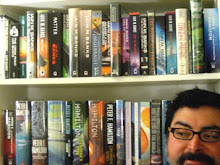Up until this point I did not know that the NaNoWriMo (National Novel Writing Month) organization had set up a Young Writer's Program. In the traditional model of the yearly event, writers from around the world participate in a month-long attempt in November to write a 50,000 word novel. The junior version requires students write smaller and reasonable amounts. To back up this process NaNoWriMo has various activities and materials to guide students through the process. Kim took these materials an extra step and treated her students like serious novelists working for a publishing house. She would spend September and October working with the students on various narrative concepts, like plot and pacing, and creating outlines, and then they would spend November writing. In January they would begin the process of revising re-writing and editing, and by late spring the books would be ready. But what then?
That's where Kim thought I could play a part. So we hammered out the details and through the spring of 2012 I worked with Kim and the students to design their book interiors and covers. Several students contributed artwork for their covers, others included drawing for the chapters, and others worked with me on concepts.
Once the book designs were ready, I used Ginger, our Book Machine, to print out a proof copy for each student. And on the last day of school I presented them with their books.
 |
| Home Education Exchange First Year Student Novelists |
This year, instead of the initial 11 students, we had 18. Several were repeat students working through the process again, but there were new writers as well. We began the design project in the early spring, with the cover concepts being hashed out. As we approached May, Kim was busily corralling the students and their edits and manuscripts. Unforeseen circumstances in timing delayed the delivery of all manuscripts, but by early May I was elbow-deep in book layout and artwork and imagery. Kim and I would trade dozens of emails reviewing the comments by the students and their parents on my designs. We would go through various rounds of this as we honed each design to the exact needs of each student.
Every story required a different approach: epic fantasy, kidnapping thriller, Alice in Wonderland-style journeys, fantasy-sci-fi planetary adventures. I worked with more artwork than the year before, as well as many requests for interior layout (inserting maps, artwork; using special fonts for epistolary elements like phone texts and notes), fonts for chapter headings.
I was once again, thrilled and astounded at the rampant creativity and humor evident in the books, and the audacity of some students to break the 4th wall and talk directly to the reader. And in the case of one student, the bravery to choose to kill her narrator and end it with an amazing sentence: "That's all it took for me to no longer be a part of this world."
 |
| Home Education Exchange, Year Two of Student Novelists Program |
Today I had the honor of handing the proofs to the students and it was a treat to see their reactions to their book designs. It's one thing to look at a PDF of a cover or interior and see the book taking shape, it another thing entirely to hold it in your hands as a complete product.
I tell this to all my adult clients and they don't believe me until they receive their book, and then, in that moment, their expressions are exactly like the kids.
The thrill of being a published writer is not age-specific.

